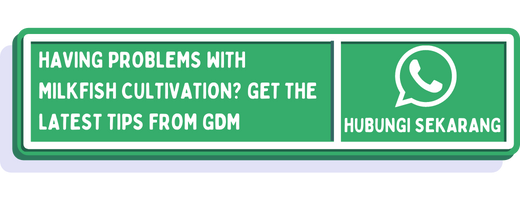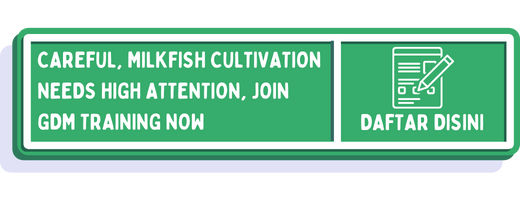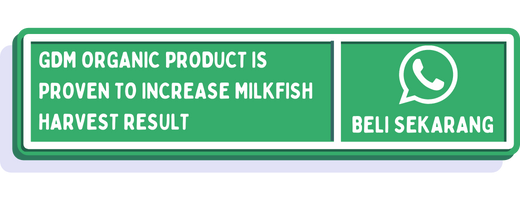How to Milkfish Cultivation Proven to Increase Harvest Results
Milkfish is one type of fish that is quite popular with the people of Indonesia. There are many factors that influence people’s choice to consume this type of fish. Ranging from soft meat, delicious taste, to cultural factors such as social status. Some people still believe that consuming this fish symbolizes social status in their environment.
Unfortunately, the high consumer interest in this type of milkfish has not been balanced by high production and productivity. Therefore, several efforts are needed, starting from intensifying cultivation results to extensification. Efforts to intensify milkfish cultivation include applied technology that must continue to be sought. One of the applied technologies in milkfish cultivation is the use of microbes as probiotics to improve the viability and weight of milkfish.
Here Are Some Tips On Milkfish Cultivation, To Increase Productivity.
1. Preparation of pools / ponds
Preparation of ponds / ponds includes activities to remove sludge, drying, liming, fertilizing and filling pre-stocked water.
A. Removal of sludge residue.
The sludge residue from the previous period of cultivation is usually collected in the middle of the pond or close to the discharge channel (sluice). These deposits contain a lot of organic material from un-digested food waste and impurities such as fases, fish skin and other residual secretions and toxic gases such as sulfide acid.
This sludge must be disposed so as not to interfere with fish growth, especially at a young age.
B. Drying.
After the sludge is clean, the pool / pond needs to be dried so that the remaining toxic gases at the bottom of the pond can evaporate. The duration of drying depends on weather conditions and soil conditions, usually between 2-3 weeks.
C. Liming.
Chalk used as agricultural lime (CaCO3) which functions to increase soil pH, control pest disease and accelerate the process of decomposition of organic matter. The need for lime used is very dependent on the condition of the soil pH.
D. Fertilization.
Provision of perfectly fermented manure will greatly help the growth of phytoplankton as a natural food for young and young milkfish. At this stage it also needs to be sprayed with GDM Black BOS 5 Kg / Hectare.
The function of spraying GDM Black BOS is to accelerate the process of decomposition of organic matter, neutralize toxins and heavy metal content, control diseases originating from the soil.
E. Pre-stocked water filling.
Pre-stocked water filling is done twice:
a. After the application of GDM Black BOS, the pond was filled with water as high as ± 30 Cm and was left to stand for 5 days with the aim of growing phytoplankton and clumps as natural nener and young milkfish.
b. After 5 days the pool is filled with water again until it is as high as 90 – 100 cm and sprayed with GDM Liquid Organic Supplements for Fisheries at a dose of 6 Liters / Hectare. The spraying of GDM Liquid Organic Supplements for Fisheries is intended to improve and maintain pool water quality. This condition is maintained for 5 days before stocking the fish.
2. Selection and stocking of fish seeds.
Fish seeds are currently being sold in fish hatcheries such as Fish Seed Centers or Hatcheries. Choose healthy fish and uniform size. Size of fish seed which is ready to be maintained in the enlargement pond is 3-5 grams / head.
The factors that must be considered in stocking fish are:
A. Stock density.
The density of fish seeds to be stocked is adjusted to the maintenance method in the enlargement pond. Stocking density in ponds with an improved traditional method is usually 2-3 fish / M3. The length of maintenance in this pond is up to fish consumption size around 4 months.
B. Time of stocking.
The ideal time for stocking fish is in the early morning until 7:30 a.m. or in the afternoon between 16:00 – 18:00 pm. Water conditions at that time were temperature fluctuations, water parameters and the environment was relatively stable.
C. Acclimatization.
Acclimatization is the process of adjusting between fish seeds and the enlargement pond environment. Acclimatization is carried out in a manner so that the fish seeds are not shocked and stressed, which in turn can result in the death of fish seeds.
3. Nursing in an enlargement pond.
Treatment in enlargement ponds includes feeding and probiotics, monitoring growth and pool maintenance.
A. Provision of feed and probiotics.
a. Fish growth is strongly influenced by the availability of good natural feed or artificial / pellet feed. Strengths in feeding (artificial) will cause accumulation of organic matter and decrease water quality. Conversely, lack of feed will cause growth fish is not optimal and susceptible to disease. Formed artificial feed pellets with different size and nutrient content according to size and size of fish. Feeding is done twice a day, morning and evening approximately 5% of the total body weight of the fish.
b. To increase digestibility and the quality of artificial feed can be added GDM Liquid Organic Supplement for Fisheries 10 ml / kilogram. GDM Liquid Organic Supplements for Fisheries can also be applied directly into water, a dose of 6 liters / hectare at once a week intervals to maintain water quality and growth phytoplankton. The availability of natural feed that is abundant can reduce the death of young juveniles and young milkfish significantly.
B. Monitoring growth.
Growth monitoring is carried out periodically to find out individual fish growth, population and biomass. Response to feed and fish health are also monitored. The data collected is then used to determine the amount of feed, the level of health and the response and when to harvest.
C. Other treatments during enlargement.
Other treatments during enlargement include water management, sluice grooming and embankments, subsequent fertilization and pest control.
a. Arrangement of water.
During the maintenance period, the water conditions that need to be considered are maintaining water depth and maintaining water quality so that fish can grow optimally.
b. Maintenance of sluice gates and embankments.
The maintenance of water gates and embankments is intended to avoid water leaks and maintain sanitation from host fish disease pests.
c. Supplementary fertilization.
Follow-up fertilization is done to maintain the supply of nutrients that support the development of natural feed. Fertilizers used can be either organic fertilizers or artificial fertilizers whose needs depend on the level of fertility and the development of natural feed.
d. Control of disease pests.
Pest control has actually been carried out since the preparation of the pond and monitoring periodically. Liming, the application of GDM Black BOS and GDM Liquid Organic Supplement for Fisheries can prevent the development of pests and diseases in fish. The good bacteria contained in GDM products can increase fish immunity in disease attacks and create uncomfortable environmental conditions for fish pests.
4. Harvest Milkfish
Milkfish harvest is done after the size of milkfish reaches the size of consumption. Harvesting can be done in stages or in total. Each method has advantages and disadvantages. With good care with the use of GDM Liquid Organic Supplements for Fisheries on a regular basis, the uniformity and weight of fish will be higher so that the benefits will be higher.





